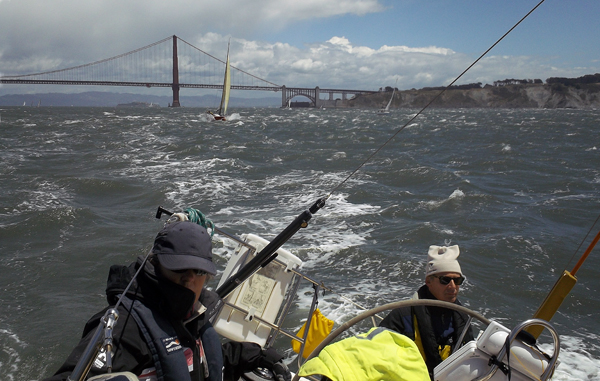
news beat
| home contact us movies galleries stories store |

 The first offshore race after the Coast Guard "re-opened the ocean" was a rough and windy slide down to Monterey in Friday's Spinnaker Cup. ©2012 Jennifer McKenna |
|
News Beat May 21-27, 2012 US Sailing Recommendations in Farallones Race Tragedy US Sailing has issued their preliminary recommendations for offshore racing, after reviewing available information surrounding the death of five sailors from Low Speed Chase in the OYRA Farallones Race on April 14. The US Sailing Independent Review Panel, made up of Chair Sally Lindsay Honey, John Craig, Jim Corenman, Bill Barton, and Bartz Schneider, presented their information to the new San Francisco Bay Offshore Racing Council, which includes local race organizers and yacht clubs, on Tuesday, May 22. The council has developed its goals to enhance safety and communications practices for all upcoming offshore events in the Bay Area. Their preliminary recommendations are:
Sally Honey commented, “The US Sailing Independent Review Panel for the Low Speed Chase accident has completed a substantial amount of its fact-finding agenda, including a questionnaire to all racers in the Farallones Race; personal interviews with racers, including survivors and witnesses; and plots and analysis of two dozen GPS tracks around Southeast Farallon Island.” The panel's consultant for Offshore Special Regulations is Evans Starzinger. The Safety-at-Sea Committee Chair and panel liaison is Chuck Hawley. Medical advisors are Dr. Michael Jacobs and Dr. Kent Benedict . Jim Wildey is the advisor on investigation procedures and formats. A full report from the panel will be released by US Sailing in June. Read the full press release here. US Sailing Statement on Kiteboarding Decision
The vote in favor of replacing windsurfing with kiteboarding in the 2016 Summer Olympics has caused a huge amount of controversy, in response to which US Sailing released the following statement on May 23, prepared by Dean Brenner, Chairman of US Sailing's Olympic Sailing Committee: Every four years, difficult decisions are made about Olympic sailing events. The choices made always leave some part of the sailing community frustrated and feeling, at least on some level, disenfranchised. I say this as a former Soling sailor who was quite upset with decisions made in November 2000, and a long-time keelboat sailor who did not agree with the recent decisions to exclude keelboats from the Games entirely. I know, first hand, how it feels to have the part of the sport I care most about excluded. There is no right and wrong here, or good and bad. On behalf of US Sailing, I would like to raise my hand and explain the reasoning behind the votes. While the Board of US Sailing makes final decisions on all recommendations to our ISAF delegation, much of the thinking on Olympic events and equipment originates in the Olympic Sailing Committee, which I lead. The OSC believes, and I continue to support this 100%, that kites will be good for the sport of sailing, worldwide. The reasons are simple:
Is there work to be done? Every time events or equipment are changed, work is required. There will ALWAYS be more work to get a new event established vs. the continuation of an existing one. Does US Sailing have work to do in supporting the industry’s pipeline development? Of course. For kiteboarding to flourish, the kiteboarding community will need to commit to increased support in this area. US Sailing will work on developing pathways for kite sailors to make the Olympics, just as it has done in other classes. The decisions on Olympic events and equipment are never easy. But I stand behind ISAF’s decision 100%. Kiteboarding will be good for the sport of sailing, in the USA and worldwide. - Dean Brenner, Chairman, US Sailing Olympic Sailing Committee
|